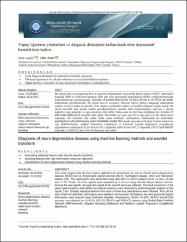Yapay öğrenme yöntemleri ve dalgacık dönüşümü kullanılarak nöro dejeneratif hastalıkların teşhisi
Abstract
Bu çalışma da yere uygulanan kuvvet sinyalleri kullanılarak Amyotrofik lateral skleroz (ALS), Huntington hastalığı (HD) ve Parkinson hastalığı (PD) gibi nöro dejeneratif hastalıkların (NDD) sınıflandırılmasında kullanılabileceği önerilmektedir. Deneyler 16 kontrol bireyi (CO), 13 ALS, 20 HD ve 15 PD'ye ait veriler kullanılarak gerçekleştirildi. İlk olarak kuvvet sinyalleri, Discrete Meyer (dmey) dalgacığı kullanılarak yedinci seviyeye kadar ayrıştırıldı. Yeni oluşan sinyallerden yedinci seviyedeki yaklaşım sinyali seçildi. Bu sinyal üzerinde tepe (peak) analizi gerçekleştirilerek sinyalin lokal maksimumları, tepe'nin x ekseni değerleri, tepe genişliği ve tepe çıkıntıları elde edildi. Daha sonra bu dört tepe özelliğinin her birinden 15 adet temel istatistiksel öznitelik elde edildi. Böylelikle sol ayak için 60 ve sağ ayak için 60 olmak üzere toplamda 120 öznitelik elde edildi. Daha sonra OneRules sınıflandırıcı kullanılarak bu öznitelikler içerisinden en çok enformasyon veren öznitelikler seçildi. Bir sonraki aşamada ise Radyal Tabanlı Fonksiyon Ağı (RBFNetwork), Adaptif Yükseltme (Adaboost) ve Eklemeli Lojistik Regresyon (LogitBoost) algoritmaları kullanılarak ALS-CO için %93,1 doğruluk, HD-CO için %97,22 doğruluk, PD-CO için %83,87 doğruluk ve NDD-CO için %92,18 doğruluk elde edildi This study suggests that the force signals applied to the ground may be used to classify neuro?degenerative diseases (NDD) such as Amyotrophic lateral sclerosis (ALS), Huntington's disease (HD) and Parkinson's disease (PD). The experiments were performed using data with 16 control subjects (CO), 13 ALS, 20 HD and 15 PD. Firstly, the force signals were separated up to level?7 using Discrete Meyer (dmey) wavelet. Among the new signals, the approach signal at the seventh level was selected. The local maximums of the peaks, peak locations, peak widths and peak prominences were obtained by performing peak analysis on this signal. Then, 15 basic statistical features from each of these four peak features were obtained. Thus, 60 for each of left and right foot, 120 features were obtained. Among these 120 features, the ones giving the highest information were selected using OneRules classifier. Respectively, 93.1%, 97.22%, 83.87% and 92.18% accuracy was obtained on ALS?CO, HD?CO, PD?CO and NDD?CO datasets using Radial Basis Function Network (RBFNetwork), Adaptive Boosting (Adaboost) and Additive Logistic Regression (LogitBoost) algorithms



















